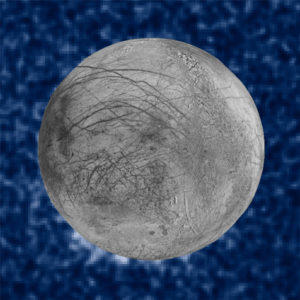
Credits: NASA/ESA/W. Sparks (STScI)/USGS Astrogeology Science Center
NASA made an interesting discovery public today: it appears plumes of water vapor are erupting off the surface of Jupiter’s moon, Europa. Astronomers using NASA’s Hubble Space Telescope have imaged the action on Europa, bolstering other Hubble observations suggesting the icy moon erupts with high altitude water vapor plumes. The plumes are estimated to rise about 125 miles before, presumably, raining material back down onto Europa’s surface. Europa has a huge global ocean containing twice as much water as Earth’s oceans, but it is protected by a layer of extremely cold and hard ice of unknown thickness. The plumes provide a unique opportunity to gather samples originating from under the surface there without having to land or drill through the ice.
“Europa’s ocean is considered to be one of the most promising places that could potentially harbor life in the solar system,” said Geoff Yoder, acting associate administrator for NASA’s Science Mission Directorate in Washington. “These plumes, if they do indeed exist, may provide another way to sample Europa’s subsurface.”
The team, led by William Sparks of the Space Telescope Science Institute (STScI) in Baltimore observed these finger-like projections while viewing Europa’s limb as the moon passed in front of Jupiter. “The atmosphere of an extrasolar planet blocks some of the starlight that is behind it,” Sparks explained. “If there is a thin atmosphere around Europa, it has the potential to block some of the light of Jupiter, and we could see it as a silhouette. And so we were looking for absorption features around the limb of Europa as it transited the smooth face of Jupiter.”
The original goal of the team’s observing proposal was to determine whether Europa has a thin, extended atmosphere, or exosphere. Using the same observing method that detects atmospheres around planets orbiting other stars, the team realized if there was water vapor venting from Europa’s surface, this observation would be an excellent way to see it. In 10 separate occurrences spanning 15 months, the team observed Europa passing in front of Jupiter. They saw what could be plumes erupting on 3 of these occasions.
Discoveries on other planets and moons in our solar system can inform scientists on Earth how the weather, environment, and atmosphere exists here. By understanding the dynamics at play in places like Europa, we may be better to able to understand the origins of our atmosphere and the processes that maintain it.